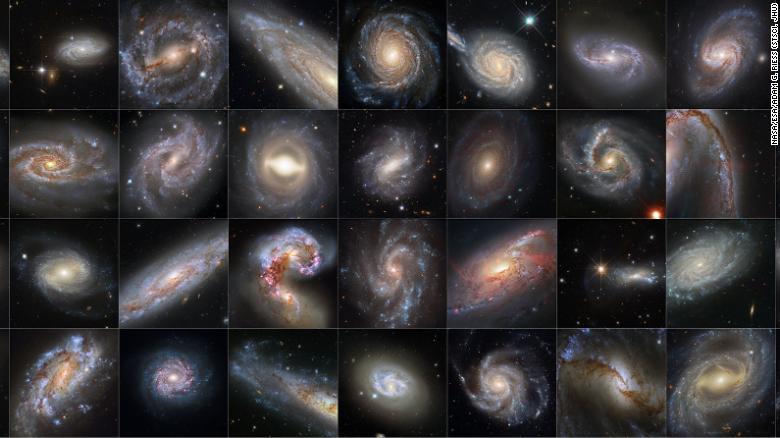Hubble's most important findings on its 32nd birthday 0:50
(CNN) --
The Hubble Space Telescope has looked directly into the heart of a stunning galaxy.
The observatory captured this front view of a grand design spiral galaxy, called NGC 3631, located about 53 million light-years from Earth.
The celestial system is in the direction of the constellation of the Great Bear.
1 of 17
|
The Hubble Space Telescope captured a spectacular front view of a grand design spiral galaxy, called NGC 3631, located about 53 million light-years from Earth.
WATCH THE GALLERY ➡️
2 of 17
|
This collection of 37 Hubble Space Telescope images, taken between 2003 and 2021, includes galaxies that host Cepheid variables and supernovae.
They serve as cosmic tools to measure astronomical distance and refine the expansion rate of the universe.
3 of 17
|
This is the first image of Sagittarius A*, the supermassive black hole at the center of our galaxy, taken by the Event Horizon Telescope project.
4 of 17
|
Two galaxies, NGC 1512 and NGC 1510, appear to dance in this image from the Dark Energy Camera.
The galaxies have been in the process of merging for 400 million years, causing waves of star formation and warping both.
5 of 17
|
This illustration shows exocomets orbiting the nearby star Beta Pictoris.
Astronomers have detected at least 30 exocomets in the system, which is also home to two exoplanets.
6 of 17
|
This artist's impression shows a two-star system, with a white dwarf (foreground) and a companion star (background), where a micronova explosion may occur.
Although these stellar explosions are smaller than supernovae, they can be intensely powerful.
7 of 17
|
This sequence of images shows how the solid nucleus (or "dirty snowball" heart) of comet C/2014 UN271 was isolated from a large layer of dust and gas for measurement.
Scientists believe that the core could be 136.7 km in diameter.
8 of 17
|
The Hubble Space Telescope has captured an image of the most distant star yet: Earendel, which is nearly 13 billion light-years away.
9 of 17
|
Astronomers have captured images of a space phenomenon called odd-radius circles using Australia's SKA Pathfinder telescope.
These space rings are so massive that they measure about a million light-years across, 16 times larger than our Milky Way galaxy.
10 of 17
|
This illustration shows what happens when two large celestial bodies collide in space, creating a cloud of debris.
NASA's Spitzer Space Telescope saw a cloud of debris block light from the star HD 166191.
11 of 17
|
Astronomers have mapped some 4.4 million space objects billions of light-years away, including 1 million space objects that have not been seen before.
The observations were made by the sensitive Low Frequency Array telescope, known as LOFAR.
12 of 17
|
An unusual triangle shape made up of two galaxies coming together in a cosmic tug-of-war has been captured in a new image taken by NASA's Hubble Space Telescope.
The head-on collision between the two galaxies fueled a frenzy of star formation, creating "the strange triangle of newly minted stars."
13 of 17
|
This image of supernova remnant Cassiopeia A combines some of the earliest X-ray data collected by NASA's Imaging X-ray Polarimetry Explorer, shown in magenta, with high-energy X-ray data from NASA's Chandra X-ray Observatory. NASA, in blue.
14 of 17
|
This image shows the Milky Way as seen from Earth.
The star icon shows the position of a mysterious repeating transient.
The spinning space object emitted radiation three times an hour and became the brightest source of radio waves visible from Earth, acting like a celestial beacon.
15 of 17
|
This Hubble Space Telescope image shows the Henize 2-10 dwarf galaxy, which is full of young stars.
The bright center, surrounded by pink clouds, indicates the location of its black hole and star birth areas.
16 of 17
|
This image shows the Flame Nebula and its surroundings captured in radio waves.
17 of 17
|
This artist's impression shows a red supergiant star in the last year of its life emitting a tumultuous cloud of gas and undergoing significant internal changes before exploding in a supernova.
These distinctive galaxies have arms that seem to wrap around their structure, as well as the heart of the galaxy.
The arms of NGC 3631 are populated with bright regions where stars are being born, as well as dark, dusty areas.
Stars form within spiral arms due to the concentration of matter.
Slower-moving matter within the galaxy can settle, drawing in the gas and dust needed to form stars together in the inner spiral arms.
The Hubble Telescope turns 32 years old.
These are some of his most shocking discoveries in space
As this accumulation of matter becomes denser, it undergoes gravitational collapse leading to the birth of new stars.
advertising
Star formation can be seen in bright bluish-white in the new Hubble image.
Other shades of blue represent visible light, and orange shows infrared light, which is otherwise invisible to the human eye.
This image was created using data from Hubble's Wide Field Camera 3 and the Advanced Camera for Surveys.
Look at these spiral galaxies, the new discovery of the Hubble telescope
Spiral galaxies are incredibly common throughout the universe, while grand design spirals are rarer.
They stand out for their very well defined spiral arms.
Photos Galaxy Hubble Telescope

